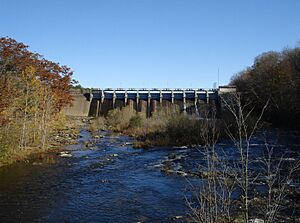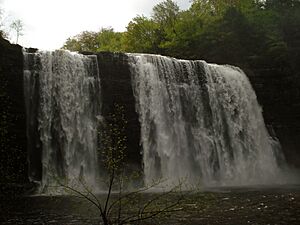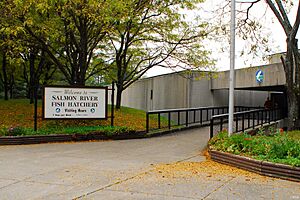Salmon River (New York) facts for kids
Quick facts for kids Salmon River |
|
|---|---|
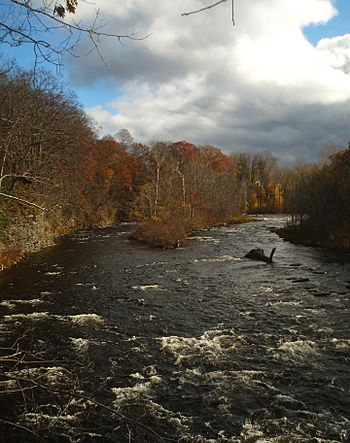
View of the Salmon River as it passes through Pulaski, November 2009
|
|
|
Location of the mouth of the Salmon River in New York State
|
|
| Country | United States |
| State | New York |
| Region | Upstate New York |
| Physical characteristics | |
| Main source | Tug Hill Town of Montague, Lewis County 579 m (1,900 ft) 43°41′34″N 75°41′15″W / 43.69278°N 75.68750°W |
| River mouth | Lake Ontario Port Ontario, Town of Richland, Oswego County 76.2 m (250 ft) 43°34′32″N 76°12′14″W / 43.57556°N 76.20389°W |
| Length | 71 km (44 mi) |
| Basin features | |
| Basin size | 725 km2 (280 sq mi) |
| Tributaries |
|
The Salmon River is a small river in Upstate New York, United States. It flows north of Syracuse. It's a very popular spot for sportfishing. Many people come here to fish, making it important for the local economy. The Salmon River is the most fished river that flows into Lake Ontario in New York.
The river starts in the Tug Hill area of New York. It flows 44 miles (71 km) west. Along its path, it goes past two hydroelectric dams. It also flows over the 110-foot (34 m) Salmon River Falls. Finally, it empties into eastern Lake Ontario at Port Ontario in Oswego County. The area of land that drains into the Salmon River is about 280 square miles (730 km2).
The river is famous for its salmon fishing. This is possible thanks to the Salmon River Fish Hatchery. The hatchery is located near Altmar. Staff there raise over three million young trout and salmon every year. These fish are then released into streams and lakes across New York State, including the Salmon River.
The river got its name from the landlocked Atlantic salmon. These fish were very important to Native Americans and early settlers. However, these native salmon disappeared from the river by 1872. They were gone from Lake Ontario by 1898. Since the late 1960s, the Salmon River has been stocked with new fish. These include Chinook salmon, coho salmon, steelhead, and brown trout. Some Atlantic salmon are also added. These fish return to the river each year to spawn. They spend most of the year in Lake Ontario.
The Salmon River is also a great place for kayaking and river rafting. This happens when water is released from the Lighthouse Hill Dam. Several companies offer trips on the river.
Contents
River's Journey: From Source to Lake
The Salmon River has different parts and features along its path.
Where the River Begins
The headwaters of the Salmon River are in western Lewis County. This area is part of New York's Tug Hill region. The main smaller rivers that feed the Salmon River are the North Branch Salmon River and the East Branch Salmon River. The North Branch is also fed by the Mad River. The upper parts of the river are mostly covered by forests. There are not many people living there. This helps keep the river's water quality very high.
Salmon River Reservoir: A Man-Made Lake
The Salmon River Reservoir, also called the Redfield Reservoir, is a man-made lake. It is about 6.9-mile-long (11.1 km) and is in Oswego County. This reservoir was created in 1912 when a hydroelectric dam was finished. It covers an area of 2,660 acres (10.8 km2). The deepest part is 50 feet (15 m). It can hold 56,000 acre-feet (69,000,000 m3) of water. This is the larger of the two reservoirs on the Salmon River.
Salmon River Falls: A Natural Wonder
The Salmon River Falls is a 110-foot (34 m) waterfall in Oswego County. It is about 15 miles from where the river meets Lake Ontario. The falls are located between the Salmon River's two reservoirs. They are part of the 112-acre (0.45 km2) Salmon River Falls Unique Area. This area is managed by the New York State Department of Environmental Conservation.
Before 1993, the power company Niagara Mohawk owned the falls and the land around them. Then, ownership was given to New York State. Since then, the area has been improved. It now has parking, trails for wheelchairs, and signs that explain the area's history. It's a popular place to visit. In the past, the falls were the natural limit for salmon swimming upstream to spawn. This was before the Lighthouse Hill Dam was built.
Lighthouse Hill Reservoir: Another Important Lake
The Lighthouse Hill Reservoir is also known as the Lower Salmon River Reservoir. It is in Oswego County near Altmar. It's about three miles (4.8 km) downstream from the Salmon River Reservoir. This 164-acre (0.66 km2) reservoir was created in 1930. That's when the Lighthouse Hill Dam was completed. This dam is the first barrier for salmon and trout trying to swim upstream.
The Main Part of the River
The main part of the Salmon River stretches for 16 miles (26 km) below the Lighthouse Hill Dam. It flows through Altmar and Pulaski before reaching Lake Ontario. This section of the river is where salmon from Lake Ontario can swim. Because of this, it is the most popular part of the river for anglers (people who fish). The amount of water flowing here is controlled by the Lighthouse Hill Dam. In summer, water is released for whitewater rafting.
Two smaller streams, Trout Brook and Orwell Brook, join the river below the dam. Salmon and trout can also swim into these streams. Anglers often fish there too. Salmon might also go up Beaverdam Brook. However, fishing is limited there. This is because the Salmon River Fish Hatchery is connected to this stream. The hatchery takes in adult fish for breeding. It also releases young fish there.
River's History
Early Days and European Arrival
Before Europeans arrived, the Salmon River area was important to the Iroquois Confederacy. They used it for seasonal hunting and fishing. They had many names for the river. One name was Heh-hah-wa-gah, which meant "where swim the sweet fish". The river was also a path to hunting grounds. In 1688, it was called "the place where the greater part of the Iroqouis embarked to go upon the trail of the beaver." This was for their trips into the Tug Hill area.

In 1615, French explorers like Samuel de Champlain explored the river. They claimed the area for New France. Early maps called the river La Famine. This name came from French colonists who were hungry when they passed through in 1656. An Iroquois village was also noted near the river's mouth. La Famine was known as a stopping place for hunters and explorers. Armies and ambassadors also met there.
Records from 1657 show that Iroquois fishermen caught many Atlantic salmon from the river. They would dry or smoke the fish for winter. One source said the river had so many salmon that the Iroquois "often brought up a hundred at one cast of the net."
The Salmon River was known for its natural harbor and many fish. So, the lower river was fought over by the French, British, and Iroquois. This happened during the French and Indian Wars (1688-1763). The British eventually took control. But their control didn't last long. The United States became independent after the American Revolution in 1783. The Iroquois were also weakened because they sided with the British.
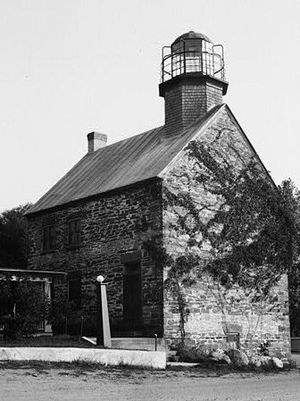
The first permanent American settlement was built in 1801. It was near the river's mouth. The village of Pulaski started in 1804 with a single log cabin. The stone Selkirk Lighthouse was built near the river's mouth in 1838. It is still there today. The lighthouse helped ships navigate Lake Ontario. It also collected taxes on goods from Canada.
The river has always been a source of food and power. Many dams and mills were built in the 1800s. These dams helped the growing population. But they also stopped salmon from reaching their spawning grounds upstream. This led to the disappearance of landlocked Atlantic salmon from the river by 1872.
Changes and Floods
The Salmon River changed a lot in the early 1900s. This was due to the building of hydroelectric dams and their reservoirs. Between 1912 and 1930, dams and reservoirs were built both upstream and downstream of the Salmon River Falls.
Major floods have happened on the Salmon River. One big flood was from December 29, 1984, to January 2, 1985. Snow melted quickly, and there was heavy rain. This caused a lot of damage. Bridges were destroyed, and roads and homes were damaged in Pulaski and Altmar.
Another historic flood happened on September 30, 2010. Heavy rain fell in just a few hours. The water was so high that a bridge in Pulaski was almost covered. A wall along the river was washed away. During this flood, 26,000 cubic feet per second of water flowed through the river. This was almost as much as the 1984 flood. Normally, river levels are much lower. People saw salmon swimming in flooded parking lots and roads. Anglers even tried to catch them there.
Protecting Fish: History of Fisheries Management
Salmon populations in the Salmon River dropped quickly in the mid-1800s. This was because of too much fishing, pollution, and dams. By 1872, native salmon were gone from the river. Between 1873 and 1898, about 1.1 million Chinook salmon were added to the river. But this stopped because the fish weren't reproducing naturally. Attempts to add Atlantic salmon also failed. By 1898, all salmon in Lake Ontario seemed to be gone.
More attempts to bring back Chinook, coho, and Atlantic salmon happened between 1939 and 1959. But these also failed. Bad river conditions, pollution, and parasitic sea lampreys were part of the problem.
In the 1950s, lake trout disappeared from Lake Ontario. This left the lake without a main predator. Fish like alewife and smelt grew in huge numbers. Sometimes, so many alewives died that bulldozers were needed to clear them from beaches. To control these fish, more coho and Chinook salmon were added to the Great Lakes and their rivers.
In 1968, 22,000 coho salmon were put into the Salmon River. This started the modern era of salmon fishing there. Chinook salmon were added starting in 1970. At first, not many fish returned. But when sea lamprey control began in 1972, things improved. By 1974, large salmon runs were common. Steelhead trout were also added that year.
To support the growing fishing industry, the Salmon River Fish Hatchery was built in 1980. It's on Beaverdam Brook, near Altmar. The hatchery gets its Chinook, coho, and steelhead broodstock (adult fish for breeding) directly from the river. It also raises brown trout and Atlantic salmon using eggs from other places. In total, the hatchery raises almost three million young fish each year. These fish are released into New York's waters.
Fishing rules and stocking levels have changed over time. This is based on how many prey fish there are, river conditions, and public opinion. From 1976 to 1977, catching salmon in Lake Ontario was banned. This was because of high levels of chemicals like Mirex and PCBs. In 1995, a fishing method called snagging was banned. This was due to ethical concerns and problems on the river.
For many years, the water flow below the Lighthouse Hill Dam changed often. This was because of changing demands for electricity. In 1996, new rules were set for hydroelectric power. These rules helped manage river flows. The goal was to improve the river's natural habitat. Managed flows led to more natural reproduction of Chinook salmon. They also made the river more fun for recreation. Planned high-water releases now allow for whitewater rafting in the summer.
Atlantic salmon stocking started again in the Salmon River in 1995. A few years later, a small summer fishery was established. But it wasn't until 2009 that Atlantic salmon were seen reproducing naturally. This was the first time in over a century that naturally reproduced Atlantic salmon were found in the Salmon River.
In 2015, the Salmon River was stocked with many fish. This included 360,000 Chinook salmon, 90,000 coho salmon, and 30,000 Atlantic salmon. Also, 263,220 steelhead, 1,150 rainbow trout, 1,200 brown trout, and 910 brook trout were added. These numbers include fish released from the Salmon River Fish Hatchery.
Fun on the River: Sportfishing
The Salmon River is a very popular place for sportfishing. It's especially busy in the fall and early spring. In 2007, it was estimated that anglers spent almost 201 million USD each year at the Salmon River. From 2011-2012, more fishing happened on the Salmon River than on all other New York Lake Ontario rivers combined. About 60% of anglers on the Salmon River are from outside the area.
Most sportfishing happens between Lake Ontario and the Lighthouse Hill Dam in Altmar. Here, anglers try to catch salmon and trout. These fish swim upstream from the lake to spawn. The types of fish that swim up the river seasonally are Chinook salmon, coho salmon, brown trout, Atlantic salmon, and different kinds of steelhead. People fish for salmon by casting from the shore. They also use waders to fish from inside the river. Some fish from a drift boat, often with a guide.
The fish in Lake Ontario have a lot of food. This means the fish that swim up the river can get very big. Two world record fish have been caught in the Salmon River. A 33 lb 4 oz (15.1 kg) coho salmon was caught in 1989. A 35 lb 8 oz (16.1 kg) Chinook-coho hybrid was caught in 2001. Also, the largest Chinook salmon ever caught in the Great Lakes was from the Salmon River in 1991. It weighed 47 lb 13 oz (21.7 kg).
How Anglers Can Access the River
Anglers can easily reach most of the lower river. This is because of special agreements called conservation easements on private land. There are also many parking areas and trails. These are kept up by the New York State Department of Environmental Conservation and local towns. These easements allow access only for fishing. Other activities like camping or hunting are not allowed.
Special areas for fly fishing and catch and release only are available above Altmar. There is also a section of the river where you have to pay to fish. This is below Pulaski and above the NYS Route 3 bridge. It's called the Douglaston Salmon Run.
Fishing in the Fall Season
Fishing is busiest during the fall salmon runs. This is usually from mid-September to early November. During this time, Chinook and coho salmon come to spawn. Most coho salmon follow the earlier Chinook runs. Both of these fish die after spawning. So, anglers try to make the fish strike by using baits that make them aggressive. The fish don't eat after they enter the river.
Atlantic salmon also spawn in the Salmon River in the fall. Most spawn in October and November. Some might enter the river as early as July. These fish can spawn multiple times in their lives. Many will return to Lake Ontario after spawning.
Fishing in Winter, Spring, and Summer
As the Chinook and coho runs end, some steelhead and brown trout enter the river. They come to feed on salmon eggs. Some of these fish stay in the river all winter. They spawn between mid-March and early April. More fish enter the river at this time. Fishing on the Salmon River gets busy again during this spring spawning season. Both brown trout and steelhead can spawn many times. Many "drop back" to Lake Ontario after spawning. These fish eat aggressively and are popular with anglers.
The stocking of "summer-run" steelhead (skamania) helps increase summer trout fishing. These fish tend to enter the river as early as June.
Fishing Above the Main River Section
Salmon and trout cannot swim past the Lighthouse Hill Dam. But anglers still use the reservoirs and river sections above the dam. However, fewer people fish here than in the lower river.
The Lighthouse Hill Reservoir has fish like resident rainbow trout, largemouth bass, and brown trout. It also has common species like yellow perch, rock bass, brown bullhead, bluegill, and pumpkinseed sunfish. The upper Salmon River Reservoir has both largemouth and smallmouth bass. It also has some walleye, brown trout, brook trout, and rainbow trout. Black crappie, yellow perch, and bluegill are also in this reservoir. Above the upper reservoir, the North Branch Salmon River and the Mad River are stocked with brook trout every year. The East Branch Salmon River is stocked with both rainbow trout and brook trout.
Rules for Fishing
Anglers on the Salmon River must follow New York State's general fishing rules. There are also special rules just for the main part of the Salmon River.
The Snagging Ban
Snagging is a way of catching fish by ripping weighted hooks through the water. This was banned on the Salmon River in the early 1990s. Some people used to say snagging was okay. They argued it was hard to make Chinook and coho salmon bite. This is because these fish die after spawning and don't eat in the river.
However, people who wanted the ban pointed out that other fish in the river survive after spawning. These include steelhead, brown trout, and Atlantic salmon. Snagging would harm these fish too. Also, opponents of snagging said it was not fair. They noted that snagging was linked to injuries and bad behavior. This included littering and arguments among anglers.
Snagging had been banned in many New York State waters before the 1990s. But it continued on the Salmon River and other Lake Ontario rivers. This was because people worried about losing money if it was banned. One study predicted that fishing activity would drop by about 25%. Despite these worries, New York State banned snagging, and it became law in 1995.
The popularity of salmon fishing in the Lake Ontario area did decrease in the late 1990s. The snagging ban might have played a part in this. However, in the 2000s, salmon fishing on the Salmon River became popular again. Today, it is one of the most fished rivers in New York State. Also, the way people behave and the general feeling along the Salmon River have improved since the ban.
Even though the snagging ban has been in place for over 20 years, some illegal snagging still happens. Enforcing the ban is a top priority for Environmental Conservation Officers. They patrol the river during peak salmon season. Sometimes they use hidden methods to catch people snagging.




